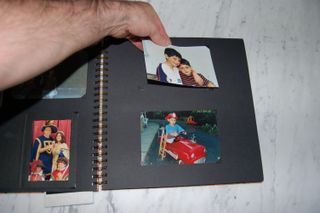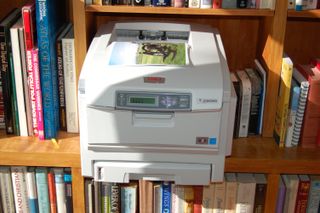Digital Picture Frame Vs. Photo Album
For Mother’s Day, should you get your mom a photo album or a digital picture frame? Which is more enjoyable, and which is greener? We measure and find out.
Pros and Cons of Physical Albums
The traditional paper photo album has existed for nearly as long as cameras, and just about every family has at least one. While they are a nice place to put a few hundred photos, albums aren’t good for showing off lots of pictures, and are static representations.
Photo albums are perfect for stashing up to a couple hundred paper pictures in a small space, but it can take hours to arrange and affix them to the pages. Once they’re mounted, it’s hard to change the layout of the photos, and I’ve found that over the years, regardless of whether you use tape, glue or corners, eventually some will fall out.
An album with 50 large pages can hold roughly 275 assorted photos from 3- by 5- and 4- by 6-inch snapshots to 5- by 7- and 8- by 10-inch enlargements. It can be fun to arrange and place the photos, but it takes a lot of time. We figure that after you’ve selected which pictures you want to use, a 50-page album will take as much as four hours of work.

The good news is that unlike a digital picture frame, it takes no extra time to orient the photos so that they’re facing the right way up. A digital frame requires that the images be individually rotated and resaved in an image editing program so you don’t end up with a picture of Uncle Ralph laying on his side alongside the Statue of Liberty.
Like any other book, you can take the paper album wherever you go. Obviously, it doesn’t need electricity, unless you want to look at it at night. A good album with acid-free paper should preserve the prints for decades, if not centuries. I have a tattered album from the late 19th century of long-gone family members and the photos are usually in much better shape than the paper on which they’re mounted.
I’m in the midst of scanning several boxes of family photos that I recently inherited. Along with my own digital photos, my total paper photo collection adds up to more than 13,000 images that could go in paper albums. But even if I’m ruthless in my editing, the collection will end up filling up a dozen albums at about 6 pounds each, on a bookshelf with sagging shelves.

I want, new, properly edited, clean-looking photos for my albums, so of course I have to print them out. That can get very expensive, very fast. Kodak’s Web site charges 30 cents to print a 4- by 6-inch photo, $1.59 for a 5- by 7-inch and $4.25 for an 8- by 10-inch. My mix of 275 images might come to nearly $350 if I used this service. The attractive gift album itself will cost about $50 from Kodak, coming to a total of $400.
Doing this requires no energy input on my part other than sorting and mounting the pictures, but there are costs to the environment from the processing and shipping of the prints. Traditional photo processing is very water intensive, uses caustic chemicals, and can release silver into the environment.
There’s a less expensive way, however: printing the photos myself. With a color laser printer, like the OKI C6050n, the cost drops dramatically. The printer has a resolution of 1,200 dots per inch and an excellent color enhancement mode for printing photos. They’re not as sharp and rich as professionally printed images but with special glossy photo paper they look quite good.
Inkjet printers do a pretty good job of printing photos as well. They typically use less power but are slower and often have ink that costs five- to ten-times more than laser printers per print.
Rather than using 275 sheets of photo paper, I can cut the price and effect on the environment of this project by combining some of the smaller images I want to print onto these larger sheets, using POS’s Multiple Image Printing Wizard (link to mini review). Then, I’ll cut them up and mount them in the album later. I’ll need a package of 100 sheets, which costs $21, to fill my 50-page album.
According to Gary Peterson, principal analyst at Gap Intelligence, a research firm that covers the consumer photo printing business, the Oki C6050n costs between 20- and 47 cents per page to produce photo-quality prints. His company looks at the costs, from acquisition to consumable items, including toner and replacement drums and fusers.

The Gap analysis leaves out one key thing: electricity. Using a Kill-A-Watt power meter, I found that printing 10 individual photos uses 0.2 kilowatt hour of electricity, so 100 sheets would consume 2 kilowatt hours of juice. That means printing my photos should cost 22 cents at the current national average of 11 cents per kilowatt hour.
That adds up to 3.2 pounds of extra carbon dioxide released into the air from a power plant to print my photos, based on the EPA’s carbon calculator . This carbon dioxide contributes to global warming, but is a tiny fraction of the 19.1 metric tons a year that the typical American is responsible for each year, according to the United Nations.
Using an average of 32 cents per page to print the photos myself, along with $21 for the paper and $50 for the album, my total cost comes to $103.22 for the entire project. That’s a lot less than the $400 it would cost to use professional prints. Either way, it’s a lot of money, but let’s see how the power cost and carbon footprint of paper prints compares to a digital album.
Pros of Albums—
They are portable, require no technology to view and can make an impressive gift.
Cons of Albums—
Photo albums are expensive to print, bulky in large quantities, and are essentially static.
Current page: Pros and Cons of Physical Albums
Prev Page Digital Picture Frame Vs. Photo Album Next Page Pros and Cons of Digital Photo FramesSign up to get the BEST of Tom's Guide direct to your inbox.
Get instant access to breaking news, the hottest reviews, great deals and helpful tips.
Brian Nadel is a freelance writer and editor who specializes in technology reporting and reviewing. He works out of the suburban New York City area and has covered topics from nuclear power plants and Wi-Fi routers to cars and tablets. The former editor-in-chief of Mobile Computing and Communications, Nadel is the recipient of the TransPacific Writing Award.
-
cadder Are any of these frames battery powered? I would like to have one to carry to family events to pass around.Reply -
bri-guy I've seen the Philips 7ff1cmi, which has a rechargeable battery but I don't think that it lasts for than a few hours.Reply
BN -
JohnnyLucky Girlfriend received a digital photo frame from her daughter last year. It was pre-loaded with photos of the grandchildren. First few days there was an initial wow factor. After that it just sat there turned off. I don't think my girlfriend has turned it on for an entire year.Reply -
bri-guy I can see that happening. I've had a frame running behind my desk for about a month, cycling through my photos and I kind of like glancing over to it every once in a while. I've been startled by some of the pictures that I haven't seen in decades. It's a nice time machine.Reply
bn -
tomate2 since you mentioned about not taking into account all the environmental impacts of making a photo album i guess who should talk about the environmental impacts of making a digital frame?? like the part of it being made by cheap labor outside of the us... the man work to keep digging up all those materials to START making a digital frame... or the bit extra electricity your using on the digital frame which comes from burning fossil fuels or flooding huge regions to build a dam... i guess you get the idea.. :DReply -
bri-guy Not justt that, but all the oil and natural gas that goes into the plastics, glass and silicon. Then, there's what to do with it after its ten (hopefully more) year life span is over and it's time to chuck it. There are times I wish I were an economist to untangle these questions. While researching the story I asked several experts in photography, including those who specialize in green photography, and none could even start to answer the question.Reply
BN -
wtlloyd Just in terms of volume of materials used, it's clear, to me at least, that if every household had an 8x10 digital photo frame, vrs every household owning a dedicated photo printer along with attendant ink cartridges, boxes of inkjet paper...the waste stream is continuous with a photo printer.Reply
The digital photo frame is clearly the way photo display is moving. Excitement over the IPad in Fine Art photography circles is over it's use as a portfolio. Recent industry pundit articles (Thomas Hogan) discussing "whither cameras" argue that the next development required to restart sales (the market is reaching saturation, and digicams are about to be made obsolete with improved camera phones) will be the communication (digital) between the photo making device and the storage and display devices.
Finally, referring to professionally printed photos vrs digital photo frames is a false argument...Fine art printing, with color balancing, tonal corrections, localized adjustments, and color managed output, is hardly typical of what you get when you send your snapshots off to Costco or wherever...Better pictures result from becoming a better photographer, not whether output is displayed on paper or screen. -
DianeJones I prefer a scapbook. A traditional photo album just doesn't have the same "wow" factor as flipping through pages of photos and memorabilia attractively displayed in a scapbook. I find that sitting a watching a digital photo frame for 15-30 minutes is very tedious.Reply
I am currently making a scrapbook for my son's graduation and have decided that when I finish that I will move on to doing other family albums so that I may enjoy the pictures instead of just packing them away in boxes. I do like the idea of a digital photo frame for a desk at work: I may check into that.
You can get 4x6 prints of digital photos from CVS for 19 cents each. I upload them from my computer and pick them up in the store. -
Another option is to put your photos in a photo book, a service offered online by many companies. They produce a hardback coffee table book with up to 84 pages holding up to 4 photos per page on photo paper.Reply
This uses no electricity and can be passed around for viewing unlike a digital frame. A portable DVD plater which is battery powered will usually display jpeg photos form a card or CD. -
joneb Erm theres somethig wrong in this article. if a digital photoframe was used like a photoalbum it wouldnt be on all the time but only when used. If the proper comparison was made what then would be the difference. I agree for photos displayed constantly prints seem definitely more environmentally friendly. But then if you have a laptop or a netbook you dont need the photoframe do you?Reply
